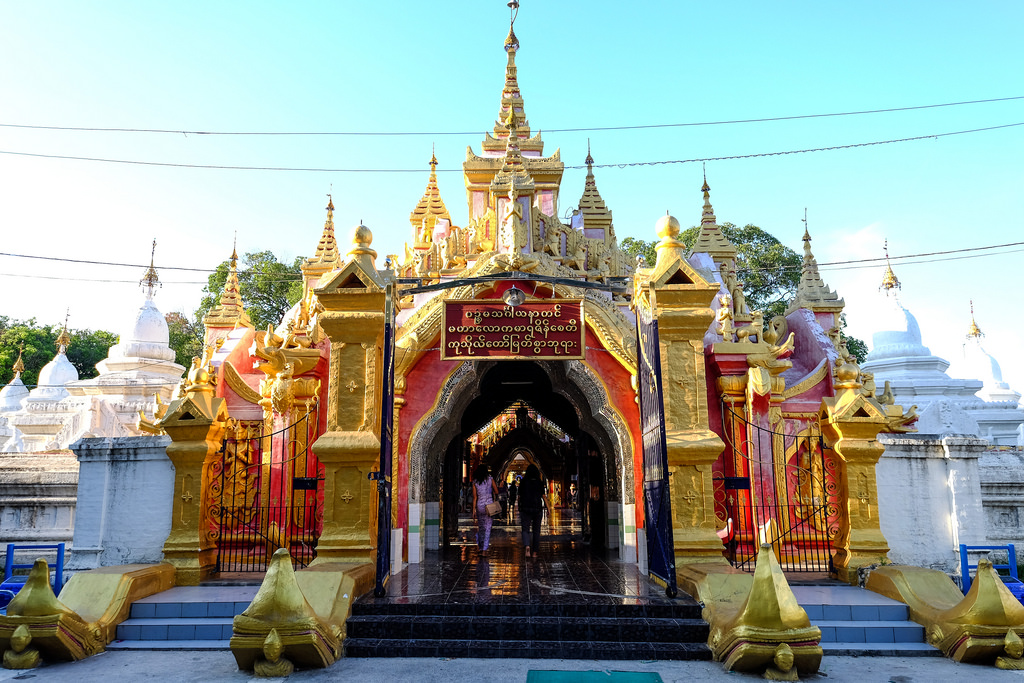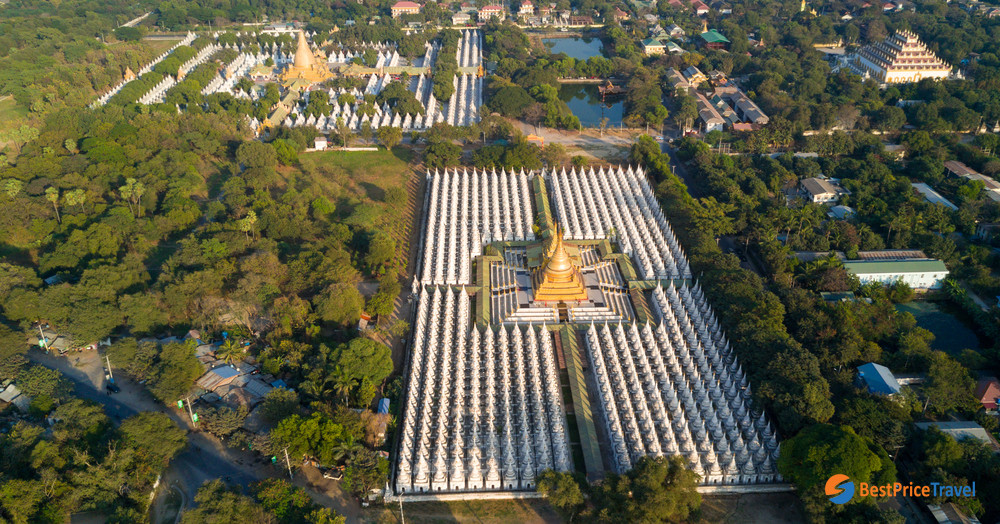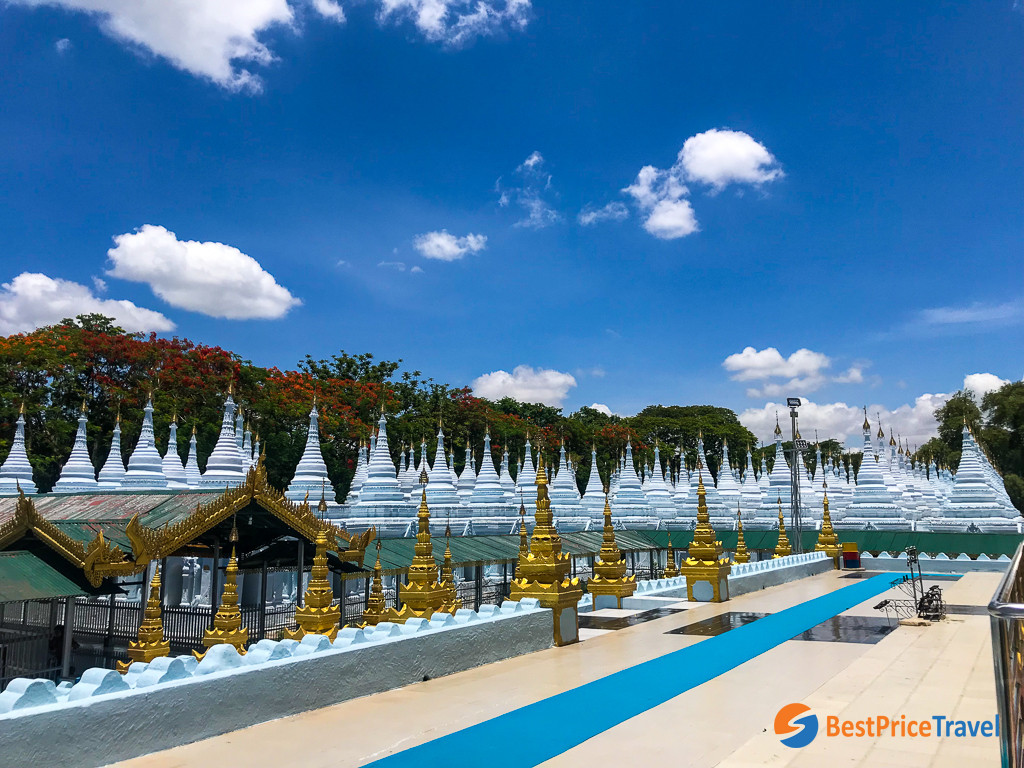Kuthodaw Pagoda
If you have a chance to come to Shwezigon at Nyaung near Bagan, you would love to pay the enormous Kuthodaw Pagoda a visit. Known as the World’s Largest Book under the name Kuthodaw Paya or Maha Lawka Marazein Paya (“Paya” means Pagoda in Burmese), this place would be one of the most remarkable places you have ever been to when visiting Mandalay.
Kuthodaw Pagoda is a Buddhist stupa located at the base of the southeast stairways to Mandalay Hill and contains the World's Largest Book. The pagoda was built during the reign of King Mindon. At the centre of the complex is a gilded pagoda modelled after the Shwezigon Pagoda at Nyaung-U near Bagan. The world's largest book is set on the grounds of the pagoda.
It has 730 leaves and 1460 pages; each page is a marble slab inscribed on both sides with a page of text from the Tipitaka, the entire Pali Canon of Theravada Buddhism. Each slab is housed in its own shrine, called ‘kyauksa gu’, with a precious gem on top, and they are arranged around a central golden pagoda. When the British invaded, they stripped away every piece of gold from the tablets along with the gems and other valuables. Today the writing is marked in black ink made from shellac, soot from paraffin lamps and straw ash. A few gems still exist.

Entrance of Kuthodaw Pagoda
The reason behind the name is because Kuthodaw is surrounded by an aggregate of more than 700 shrines, and each of them is a tremendous marble slab that was carved with Burmese scrips on both sides. The scrips originated from Sutta Pitaka, Vinaya Pitaka, and Abhidhamma Pitaka which all has contributed to coin the Tripitaka (means "Three Baskets"). From that, you can imagine if each full-of-text stone slab is a book page, then with more than 700 massive double-sided pages, Kuthodaw definitely becomes the largest book in the world.

Aerial view of the Kuthodaw Pagoda
This giant book was started building at the same time as Royal Palace by King Mindon in 1857, right after Mandalay was established. At that time, King Mindon constructed this phenomenal Paya as patrimony for their youngsters. Unluckily, the British had lived in Mandalay around the early 1860s and used Kuthodaw as a military base, then intruders destroyed the pagoda and stole all the most valuable possession like gold, jewel that was attached on the wall or put inside the pagoda. Due to this palace revolution and domestic disruption, the construction of Kuthodaw Paya got postponed and finally finished in 1878. In other words, this pagoda took 21 years to complete in total.
Kuthodaw has four entrances and all of them were decorated arches. The main entrance is on the South which is stand out for the decoration of gold and red as main colors. Next to this Southern gate is a long pathway leads you to the central stupa inside the pagoda.

Entrance door of Kuthodaw Pagoda
The marble pieces were found a few miles away from the North of Mandalay, and the craving work of Burmese texts started around October 1860 and it took them seriously almost 9 years for completing just the carving work. Originally the lettering also covered by a thin gold leaf. But after the disruption, it was very difficult for the government to fully recover Kuthodaw back to its original state. They decided to use black ink to attach to letter on stone slabs instead of new gold leaf veneer.

The enormous Kuthodaw Pagoda
On top of that, you have one more reason to be the next reader of this Kuthodaw book: it was one of the Memory of the World Register that already got approved to the list by UNESCO!
The great Kuthodaw Pagoda has daily opening hours from 8 in the morning to 8 in the evening, so you can enjoy the Greatest Book of the universe for 12 hours straight with the entrance fee of 5 US dollar/each person.
Since this is sanctuary, visitors have to wear formal clothes when visiting temples and pagodas. Make sure to keep yourself hydrated with a bottle of water, and don’t forget to capture unforgettable moments with a camera.
Trip that visit Kuthodaw Pagoda

Kuthodaw Pagoda Map
Questions & Answers (1)
things to do in it how much entry fees for local people
Local is free of charge.